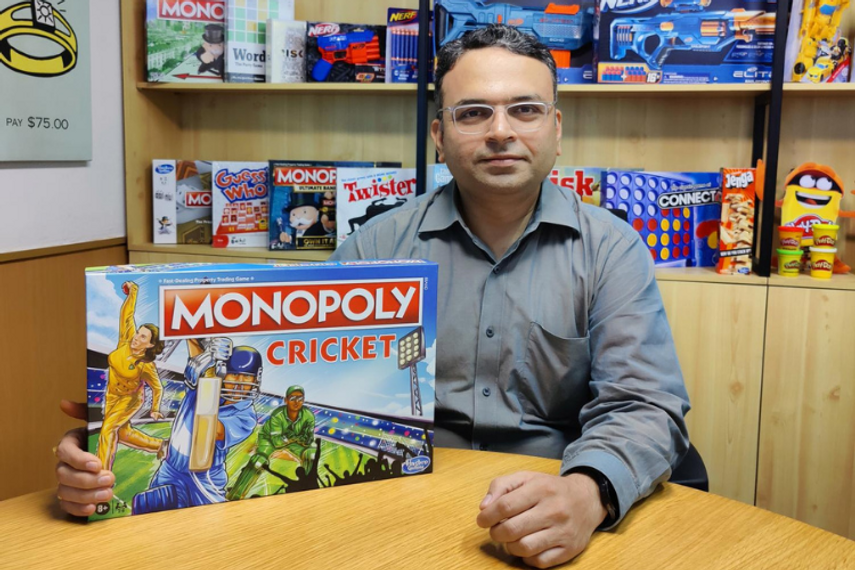
Hasbro has announced the launch of Monopoly Cricket and has rolled out a campaign for the same.
This game is conceived and manufactured in India, highlighting a commitment to local sourcing and production.
Monopoly Cricket aims to unite people for moments of fun and camaraderie, and its introduction coincides with the cricket fever sweeping the nation during the ongoing ICC World Cup 2023.
Conceptualised by League Brand Partners, the film aims to blend India's cherished sport, cricket, with the iconic Monopoly game.
We spoke to Lalit Parmar, country manager, Hasbro India, to delve into the board game company's strategy behind new launches, its approach to incorporating local languages, plans for the festive season, and its roadmap to boosting revenue.
Edited excerpts:
As you've decided to expand the product portfolio, could you discuss the process of identifying and launching variants like Monopoly Cricket, and how it aligns with Hasbro's plans for India?
Monopoly is a key focus for us, driven by innovation and tailoring to local markets. While some product concepts have global appeal, we continually seek opportunities to connect the brand with local audiences. This led to the creation of Monopoly India Edition, featuring Indian cities, as well as the launch of the Hindi version. Last year, we extended this approach to include vernacular languages like Tamil, Telugu, Malayalam, and Kannada, with city spaces representing local cities from each state. While Monopoly is a global brand, our emphasis lies in resonating with local teams and audiences, making the game relevant and topical. Our goal is to ensure that Monopoly remains a top-of-mind choice for board gamers, offering numerous opportunities and variants to explore.
Can you elaborate on Hasbro's focus on the Indian market and its efforts to introduce home-grown games and toys? What unique elements do these products bring to the market?
Our approach involves complete in-house design and development. We collaborate closely with game designers and conduct extensive testing with consumers to gain insights into what works and what doesn't in the gameplay. This includes identifying pain points, highlights, and elements that excite players. Our testing process is ongoing and serves as more than just a pre-launch phase; it's an integral part of product development. This iterative process ensures that the final offering we bring to the market is well-received and tailored to meet the preferences of the end consumers.
Where does the Indian market stand in the board game category?
Board gaming is a significant subcategory in India, and when we break down the broader category into various subcategories like board gaming, action figures, construction, creative play, and preschool, board games stand out as the largest one. This is due to the historical connection many of us have with board games, and Hasbro, with over 30 years of presence in India, has a strong legacy in this area. Many of our key gaming titles have been available in India for an extended period, and this is what we've capitalised on. Board games are a popular choice among consumers, offering a variety of options, and they are relatively straightforward to manufacture, mainly involving paper board printing, tokens, cards, and such. The board gaming space is currently thriving with significant innovation and new developments, driven by both Indian manufacturers and brand owners.
When it comes to the festive season, what are the plans for it? How much do sales increase in these months?
The festive season represents a significant opportunity for us, especially during occasions like Diwali and Christmas when gifting is prevalent. We ensure proper product distribution, and there's a strong retail focus on merchandising during this period. We actively participate in sales events on e-commerce platforms and physical stores.
During this key period, gifting is a common practice, and we engage across various channels, including traditional and modern trade. Our brands are prominently displayed, and we offer promotions and special deals on e-commerce platforms to cater to both existing and new customers. We focus on providing the best value in terms of our product offerings and prices, with numerous promotions and activities planned for the fourth quarter, starting in October. Typically, we observe a substantial increase in business during this period, with a 35-40% uptick in sales compared to the usual average.
Hasbro has ventured into regional-specific games in Hindi and Tamil for the Indian market. How has this approach played out, and what insights can you share regarding the reception of these regional games among consumers in India?
We began with the indie version of Monopoly in Hindi in 2021. In 2022, we expanded to four additional languages in the Southern region. Our approach involves continuous testing to meet our internal business benchmarks. If we successfully meet these benchmarks, we consider scaling up these offerings. These endeavours aim to create relevant products and brands for local audiences, and we're always exploring new opportunities in this regard.
Looking ahead to 2024, what are the top trends that will drive the toy industry in India, and how is Hasbro positioning itself to capitalise on these trends?
Our unique strength lies in covering a wide range of age groups and brand offerings. We have brands like Peppa Pig and Play-Doh for preschoolers, a variety of board games, toy blasters, and action figures that cater to children aged between 6-12. Additionally, we have offerings designed for young teens (14+), as well as games suitable for young adults and the entire family. Our global teams are actively working on intriguing launches, and we're exploring how to customise and manufacture these products in India for the local market.
India holds significant potential, primarily due to its low per capita consumption of toys compared to global standards. While many markets see per capita toy consumption in the range of USD 300 to USD 350, India stands at a mere USD 3 to USD 5, indicating ample room for growth. People are increasingly recognising the value of play in child development, understanding that it's not just about fun but also about fostering creativity and learning.
Play promotes interaction, skill development, and learning, such as understanding numbers, financial transactions, and property trading in a game like Monopoly. It provides a complete package that encourages digital detox, fosters in-person interaction with friends and family, creates cherished memories, and imparts valuable lessons. This holistic approach is at the core of our offerings, and we're committed to developing products that align with these principles.


.jpg&h=334&w=500&q=100&v=20250320&c=1)



.png&h=334&w=500&q=100&v=20250320&c=1)



.png&h=334&w=500&q=100&v=20250320&c=1)







.png&h=268&w=401&q=100&v=20250320&c=1)
